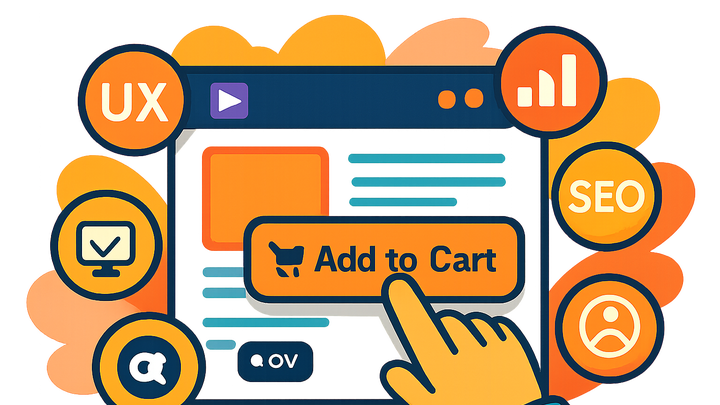Published on 2025-06-29T21:12:35Z
What is an Add-to-Cart Button? Role, Best Practices, and Examples
An Add-to-Cart Button is a key interactive element on e-commerce websites that allows users to select and store items in their shopping cart for purchase. It is critical for conversion rate optimization (CRO) because it directly impacts the ease and speed with which visitors can proceed to checkout. From a UX standpoint, the button must be clearly visible, labeled, and responsive across devices. SEO factors influence its discoverability and performance, especially when enhanced by structured data and semantic HTML. A well-designed Add-to-Cart Button can also improve accessibility by accommodating keyboard navigation and screen readers. Tools like Prevue.me can provide actionable critiques to ensure maximum lead generation, usability, and compliance. Optimizing this button involves a balance of visual design, messaging, and technical implementation to smooth the user journey from interest to purchase.
Add-to-cart button
The Add-to-Cart Button is the primary e-commerce converter, guiding users to save items for purchase with optimal UX, CRO, SEO, and accessibility.
Why the Add-to-Cart Button Matters
The Add-to-Cart Button is the pivotal element bridging product interest and purchase intent. A clear and accessible button can significantly boost conversion rates by reducing friction in the shopping journey. Conversely, a poorly designed button can lead to drop-offs at the crucial decision stage. SEO best practices such as semantic HTML and structured data can even make this element more discoverable in voice and on-page search. Tools like prevue.me can critique an Add-to-Cart Button’s visibility, labeling, and accessibility to maximize lead generation.
-
Conversion rate impact
A prominent Add-to-Cart Button can streamline the checkout funnel by minimizing clicks and confusion, directly lifting conversion rates.
-
User experience
Intuitive placement, size, and feedback (e.g., microinteractions) enhance user confidence and reduce cart abandonment.
-
Seo & accessibility
Using semantic <button> elements, ARIA attributes, and clear microcopy helps search engines index the element and supports assistive technologies.
Best Practices for Design and Placement
Effective Add-to-Cart Buttons follow proven design patterns. They should have high color contrast, descriptive text, and responsive behavior on all devices. Strategic placement near product information ensures users can easily locate the CTA. Integrating analytics events and structured data can also improve both CRO and SEO tracking. Accessibility audits via prevue.me help ensure compliance with WCAG standards.
-
Color contrast
Ensure the button color stands out from the background and aligns with brand colors to grab attention.
-
Descriptive label
Use clear and action-oriented text like ‘Add to Cart’ rather than vague labels.
-
Proximity to product details
Place the button close to key information such as price, size, and stock availability.
-
Mobile responsiveness
Make sure the button is sized appropriately for touch, with sufficient spacing to avoid mis-taps.
Common Pitfalls and How to Avoid Them
Many e-commerce sites struggle with Add-to-Cart Buttons that are hard to find, use ambiguous text, or ignore mobile and screen reader users. This section covers frequent mistakes and strategies to correct them using feedback from tools like prevue.me.
-
Low visibility
Buttons hidden below the fold or blended into the page layout lead to missed clicks and lost sales.
-
Vague copy
Generic terms like ‘Go’ or ‘Submit’ don’t convey the action; make CTAs explicit to user intent.
-
Ignoring disabled states
Failing to show why a button is disabled (e.g., out-of-stock) frustrates users; provide clear messaging.
-
Skipping accessibility
Not testing with screen readers or keyboard navigation locks out users with disabilities, harming UX and SEO.
Measuring and Optimizing Performance
To maximize impact, monitor click-through rates, A/B test variations, and analyze heatmaps for scroll and click behavior. prevue.me can surface UX, CRO, SEO, and accessibility insights, guiding iterative improvements. Combined with analytics platforms like Google Analytics and Hotjar, you can pinpoint friction points and validate design changes.
-
Click analytics
Track the number of clicks and click-through rate (CTR) to the cart page to identify performance trends.
-
A/b testing
Test different colors, labels, and placements to determine the most effective variant.
-
Heatmaps & user recordings
Visualize user interactions to see if the button is noticed and clicked as intended.
-
Prevue.me critiques
Use prevue.me for actionable critiques on button design, copy, SEO markup, and accessibility compliance.
Implementation Example
A simple HTML example showing best practices for a well-structured Add-to-Cart Button with accessibility considerations.
-
Html & aria example
Example code snippet:
<button type="button" class="btn btn-primary add-to-cart" aria-label="Add Item to Cart">Add to Cart</button>
